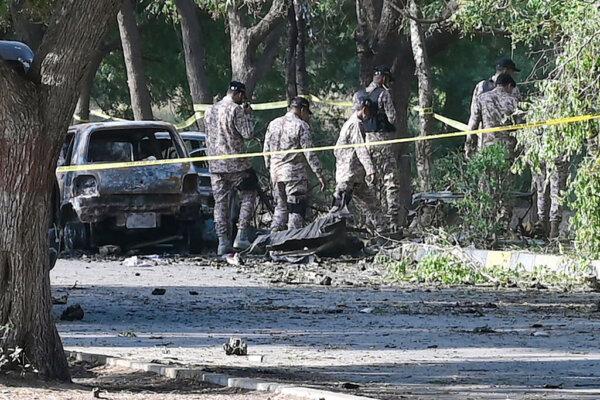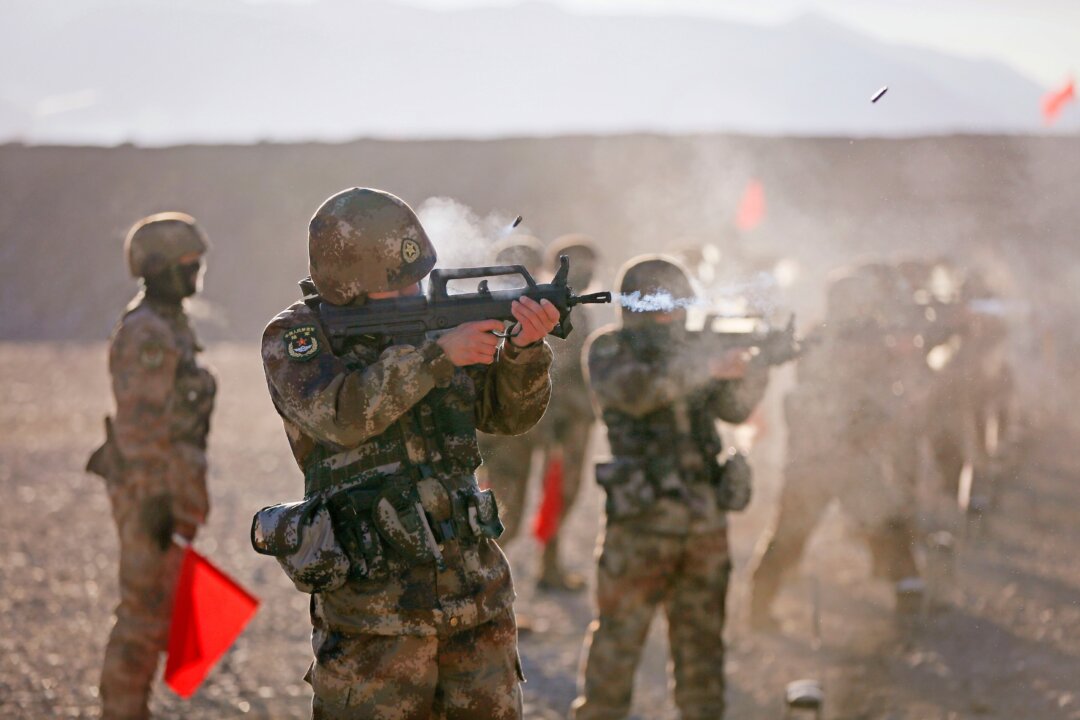Economic reliance may compel Belt and Road countries to accept Chinese security forces, in the name of protecting Chinese investments in violence-prone regions.
Troops from the People’s Liberation Army (PLA) were in an undisclosed location in Pakistan for joint anti-terrorism drills dubbed “Warrior-VIII” from Nov. 20 to Dec. 11, according to China Military Online, the English-language news website of the PLA.
Three hundred troops took part in the drills, the eighth in a special series, which took place amid increasing attacks on Chinese nationals and Pakistan’s security forces.
The attacks are ascribed to the umbrella terrorist organization Tehrik-e Taliban Pakistan (TTP), also called the Pakistani Taliban.
The drills gain more significance in light of China’s multi-billion dollar investments in the China-Pakistan Economic Corridor (CPEC), a flagship Belt and Road Initiative (BRI) project.
Experts told The Epoch Times that they may begin a pattern of similar Chinese military engagements in conflict-ridden areas like Myanmar and Afghanistan, where Beijing’s investment is at stake.
“China has [a] decades-old investment, especially infrastructure and energy-related in Myanmar, so that will continue,” said Aparna Pande, a South-Asia expert and a research fellow at the Washington-based Hudson Institute.
Nishakant Ojha, a New Delhi-based geopolitical analyst who works as a counter-terrorism advisor to various Western Asian countries, told The Epoch Times it’s likely the joint drills will be followed by Chinese troop deployment to safeguard Chinese assets in Pakistan. This will set a precedent for Chinese military engagement elsewhere in regions of conflict or crisis, he said.
“The deployment of Chinese troops to Pakistan may encourage similar actions in other nations where Chinese workers and assets face threats,” said Ojha.
He said that could include African countries such as Nigeria, Kenya, and Ethiopia, which are vulnerable to terrorist groups like Boko Haram and Al-Shabaab. It could also extend to Middle Eastern nations like Iraq and Syria, where instability and remnants of extremist groups threaten Chinese investments, and Central Asian countries like Kyrgyzstan and Tajikistan, which face security challenges from insurgencies and political unrest.
Walking a Tightrope
Pande, the Hudson Institute researcher, also cited China’s deepened cooperation with the Taliban in Afghanistan. The common thread is that Beijing “wants access to energy and minerals,” she said.
“However, in both these fragile countries, which have had or are still going through civil war-like situations, the extent to which China will be able to extract minerals and energy may depend on the security situation.”
Ojha said the Chinese have to walk a tightrope in this context, particularly in South Asia, where the Afghan Taliban and TTP have an ideological relationship.
“Through its influence over the [Afghan] Taliban, China seeks to curb the TTP’s capacity to threaten Chinese nationals and projects in Pakistan, pressuring the [Afghan] Taliban to moderate or distance themselves from the TTP,” he said.
Ojha said that the Afghan Taliban’s relationship with China may indirectly assist China in moderating TTP hostility or facilitating dialogue, further securing China’s dual interests in both Pakistan and Afghanistan.
Debt and Deployment
Ojha said China could deploy the PLA on the pretext of addressing security deficiencies in conflicted nations that are economically reliant on China and burdened with Chinese debt.
“Many BRI host nations lack the capacity to safeguard large infrastructure projects, creating an opening for China to provide security forces under bilateral agreements,” he said.
Ojha said the PLA’s presence in Pakistan could transition from temporary drills to permanent deployment, under the guise of securing CPEC projects. The latter could itself cause massive debt, adding to Pakistan’s economic woes. The result would be more reliance on China, pushing the South Asian nation to make military concessions to Beijing.
“Economic reliance on Chinese investments often compels host nations to accept Chinese security forces for protecting projects, even at the risk of sovereignty concerns,” he said.
Pande said the idea of permanent Chinese military deployment in Pakistan has been around for some time, and hasn’t been accepted by the Pakistani army.
“China and Pakistan have often had joint drills, going back a decade. There have been reports of Chinese troops in Gilgit-Baltistan again going back over a decade, to the start of CPEC,” Pande said.
The Gilgit-Baltistan region, from which the CPEC originates, is claimed by India.
“While China would like to deploy troops permanently, the Pakistan army has normally pushed back, as they do not want foreign troops on their soil. The solution that both have accepted [until] now has been a special security force for CPEC projects.”
Safdar Sial is the author of a report entitled “CPEC security developments in 2016,” published by the Pakistan Institute for Peace Studies. According to the report, a Special Security Division (SSD) was created by Pakistan in 2016 to create a four-layer security force for the CPEC. The goal is to eventually increase it to 32,000 personnel in nine composite infantry battalions and six civil armed forces wings.
Pakistan’s army has taken a “leading role in the establishment of the SSD for the protection of Chinese engineers, project directors, experts and workers employed on various Chinese-funded projects across Pakistan,” Sial said.

Ensuing Geopolitics
The presence of Chinese troops in Pakistan has always triggered concerns in India, which shares a long border with both China and Pakistan. India also claims a Pakistan-controlled territory through which the CPEC is being built.
Experts told The Epoch Times that while Pakistan and China are close allies, India in the past decade has moved closer to the United States, with which it shares an Indo-Pacific strategy at the Quad—a grouping that includes Japan and Australia as well. The China-Pakistan joint military drills have repercussions for both India and the United States, they said.
“India has long viewed China-Pakistan close security cooperation as symbolic of its two-front threat, and in recent years it has adjusted its military theaters accordingly, integrating them to the extent it can,” Pande said.
The United States understands India’s challenges on the land borders with China and Pakistan, she said, but the two countries have yet to establish a strategic territorial military partnership.
The United States “has deepened security cooperation with India, but as of now U.S.—India security cooperation is more in the maritime than the continental landmass,” according to Pande.
Ojha said that the joint drills will have significant strategic implications for the United States, given its interests in South Asia and its competition with China. According to him, the strategic partnership between China and Pakistan indicates an erosion of U.S. influence in South Asia while also highlighting regional realignment.
“The drills signify a deepening military partnership that could challenge U.S.-backed coalitions, such as the Quad,” said Ojha.
Pakistan’s growing dependence on China further distances it from the United States, he said, reversing years of American engagement in the region.
“This shift complicates Washington’s strategy in South Asia, where it aims to counterbalance China’s rise.”
According to Ojha, any closer coordination between Pakistan and China is also a threat to U.S. regional security interests vis-a-vis Afghanistan and U.S. maritime and trade security.
“Pakistan’s role in facilitating the U.S. withdrawal from Afghanistan has been critical, but a closer Sino-Pakistani military relationship could reduce Pakistan’s willingness to cooperate with the U.S. on counter-terrorism and regional stability,” Ojha said.
The CPEC links China’s Xinjiang with the Gwadar port in southwestern Pakistan’s Balochistan province, going through the northern Pakistan-controlled territories claimed by India. Balochistan is also witnessing increasing insurgency and protests against the CPEC. This year, the port faced multiple terror attacks in which several people were killed.
Ojha said the Chinese presence at Gwadar is problematic for the United States.
“Enhanced Chinese military presence in Pakistan, particularly near Gwadar Port, threatens U.S. interests in the Indian Ocean and Middle East trade routes. Gwadar’s strategic location offers China an advantage in monitoring and potentially disrupting U.S. naval operations in the region,” he said, adding that Chinese-built infrastructure, such as the Gwadar Port, can easily be militarized to support permanent bases.
Any permanent PLA presence in Pakistan would intensify the U.S.–China rivalry, according to Ojha, because it signals China’s readiness to expand its military footprint in regions traditionally under U.S. influence.
“A PLA base in Pakistan would enhance China’s ability to project power into the Middle East, Central Asia, and the Indian Ocean, directly challenging U.S. military dominance in these areas,” he said, adding that permanent PLA forces in Pakistan would increase India’s strategic vulnerabilities, especially in border areas.
“This could force the U.S. to reassess its India strategy, including enhancing military support to counterbalance China.”
Ojha also expressed concern about the probable Chinese transference of military technology to Pakistan, which could cause destabilization in the region and accelerate an arms race, further complicating U.S. efforts to maintain stability in South Asia.

